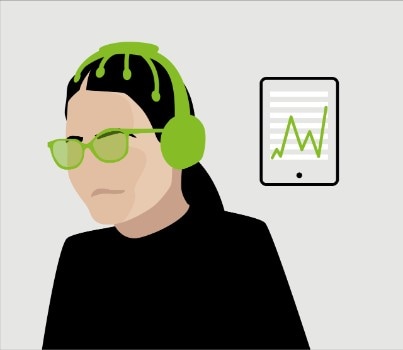Article
Eye tracking: What is really seen and what is not?
We measure where people look in order to analyze navigation, attention, distraction and visual perception
Eye tracking is a very established methodology that is used alone or in combination with other neuroscientific approaches. One main use of the eye tracker is the improvement of user interfaces (UI) or user experiences (UX), which is particularly powerful in combination with EEG. Using eye tracking we can, for example, shed light on what users and consumers actually look at when interacting with a website, store shelves, or a product, and what aspects of a message or user interface they actually focus on.
This method allows us to reconstruct gaze paths and helps to identify focus points and eye movements that study participants are not even aware of. We can measure when, in which order, and with which focus specific elements are perceived. Thus, we can quantify and analyze consciously and unconsciously perceived perspectives that cannot be identified with explicit methods.

Eye tracking can be applied to various use cases such as:
- Increasing the usability and appeal of desktop and mobile applications
- Optimizing marketing materials to draw and hold attention of target audiences
- Optimizing sales pitches and presentations to visually steer focus points and maintain high engagement
- Designing easy-to-use and engaging dashboards for managers and executives
The use of eye tracking offers significant advantages, especially in combination with EEG:
- Unbiased insights into both conscious and unconscious perception of visuals and texts
- Understanding which characteristics of visuals and texts attract attention
- Understanding where navigation paths are disturbed and by what
Did you know that visual attention follows two stages and behaves like a zoom-lens?
In general, scholars agree that every person follows two steps when it comes to visual attention. At first, our attention spreads widely across the visual scene while information is being processed in parallel. Afterwards, our attention focuses on a specific area within the visual scene and information is being processed in sequences. Moreover, scholars have found that attention works like a “spotlight”, i.e. we perceive visuals in a circular form, with a focal point in the center where we see clearly, a fringe that appears blurry to us, and a margin – the area that we completely block out when we focus our gaze. Plus, we can actively change the size of the spotlight which is why scholars also refer to this phenomenon as the zoom-lens model.
At the Deloitte Neuroscience Institute, we use eye tracking as a method to test and improve the impact of communication and user-friendliness of different media. These can be marketing brochures and videos, sales presentations, dashboards or software applications.



